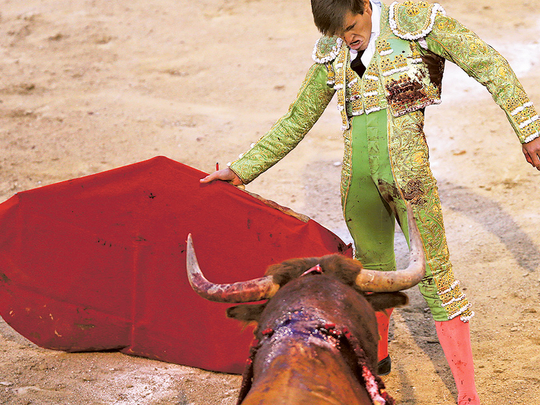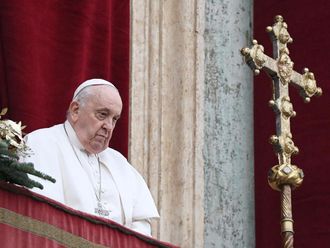
Madrid: Francisco Rivera Ordonez stood in the centre of the bullfighting ring, dressed in a shimmering “suit of lights,” just as his father had 30 years before.
Ordonez and his father shared more than their profession as matadors, however. Like his father, Ordonez went by the nickname Paquirri.
And like his father, Ordonez was about to be gored.
Ordonez stared across the dirt ring towards a 453kg bull, blood dripping from the banderillas already embedded in its hulking black shoulders. With a flick of his wrists, Ordonez beckoned the beast towards his bright pink and yellow cape.
But at the last second, the bull veered away from the cape and into the matador’s body, its foot-long horn burying itself in Ordonez’s abdomen.
And just like that, another Paquirri spilt his blood alongside the bulls.
As horrified onlookers in the Spanish city of Huesca gaped at the August 10 bloodshed, a group of men rushed Ordonez out of the ring and to a hospital. Among them: a one-eyed bullfighter named Juan Jose Padilla, his eye-patch a result of his own goring four years earlier.
For bullfighting fanatic’s, the goring of men like Ordonez, his father or Padilla are grim, but legendary moments in an ancient and blood-soaked tradition.
For opponents of bullfighting, however, Ordonez’s injury could be equally historic.
That’s because the goring of yet another Paquirri is stirring old questions about the sport, but in an age — and a country — that is increasingly against the practice of killing bulls for pleasure.
“The beginning of the end of bullfighting?” asked newspaper El Diario after Ordonez’s injury, noting that two Spanish regions have already outlawed the sport.
One reason Ordonez’s goring has stirred such strong emotions in Spain is that it came during what appears to be the country’s bloodiest week of bullfighting ever.
Eight people have died while running with the bulls this summer, according to the Daily Mail. The BBC puts the number at seven.
Either way, 2015’s tally is extraordinarily high. Only 15 people died between 1924 and 2014, according to the Independent.
In towns across Spain, summer festivals are marked by the “corrida,” or running, of bulls through town and to the bullfighting ring, where matadors dispatch the animals with bandilleras and swords.
In the past two months, however, bulls have gored men to death in the streets or rings of Penafiel and Toledo, Lerin and Valencia, Murcia, Castellon and Alicante.
Four of the men died just this past weekend, the BBC reported.
As if to cap off a week of unprecedented violence, another bullfighter was gored on Sunday. Saul Jimenez Fortes was performing in the tiny Salamancan town of Vitigudino when a bull caught him under the chin.
Both Fortes and Ordonez are expected to survive their injuries. (Ordonez’s father wasn’t so lucky, perishing in 1984 after doctors were unable to treat his wounds.)
Ordonez had only recently come out of retirement in March, according to El Pais. Instead of bullfighting year round, he was limiting himself to just the summer season “because that’s the deal I have with my woman,” he said.
But even if both bullfighters survive, their sport might not.
In 2010, Catalonia became the second Spanish province to ban bullfighting after the Canary Islands. Nearly 200,000 Catalonians signed a petition demanding that the sport come to an end.
On September 25, 2011, almost 20,000 people flooded Barcelona’s famous La Monumental bullring to watch the country’s top matadors perform there one more time.
“For a city like Barcelona to close this arena is like throwing a Picasso painting into the garbage,” one fan said at the time.
In an op-ed published Tuesday in Spanish newspaper ABC, Angel Gonzalez Abad bemoaned the “anti-bullfighting tsunami” that had swept over his country and called for a return of the sport to La Monumental.
It’s a debate that has raged for decades, if not longer. Many Spaniards consider bullfighting a tradition that reaches back through the centuries. Many others, however, call it barbarism best left to the Middle Ages.
Even if bullfighting is dying in Spain, it is hardly dead. Last year more than 7,200 bulls or calves were killed in rings across the country, according to El Diario.
The sport gained popularity among Americans after it was praised by Ernest Hemingway in his non-fiction book Death in the Afternoon.
“The only place where you could see life and death, i. e., violent death now that the wars were over, was in the bull ring and I wanted very much to go to Spain where I could study it. I was trying to learn to write, commencing with the simplest things, and one of the simplest things of all and the most fundamental is violent death,” he wrote.
Hemingway argued that bullfighting tapped into Spanish culture’s essential “interest in death.”
Many Spaniards were interested in death, he wrote, “and when they can see it being given, avoided, refused and accepted in the afternoon for a nominal price of admission they pay their money and go to the bull ring.”
Calling bullfighting “a decadent art in every way”, Hemingway said a matador “must have a spiritual enjoyment of the moment of killing. Killing cleanly and in a way which gives you aesthetic pleasure and pride has always been one of the greatest enjoyments of a part of the human race.”
After eight human deaths in one summer, however, Spain’s “interest in death” is now being tested.
The latest gorings have also rekindled criticism from abroad.
After Fortes’s injury on Sunday, British comedian and animal rights activist Ricky Gervais uploaded a video to Facebook, in which he said he rooted for the bull to win.
“The truth is I do prefer the bull to win,” he said. “I’d rather you didn’t fight a bull, but if you do — if you choose to torture an animal to death for fun — I hope it defends itself.
“Self-defence is no offence.”












